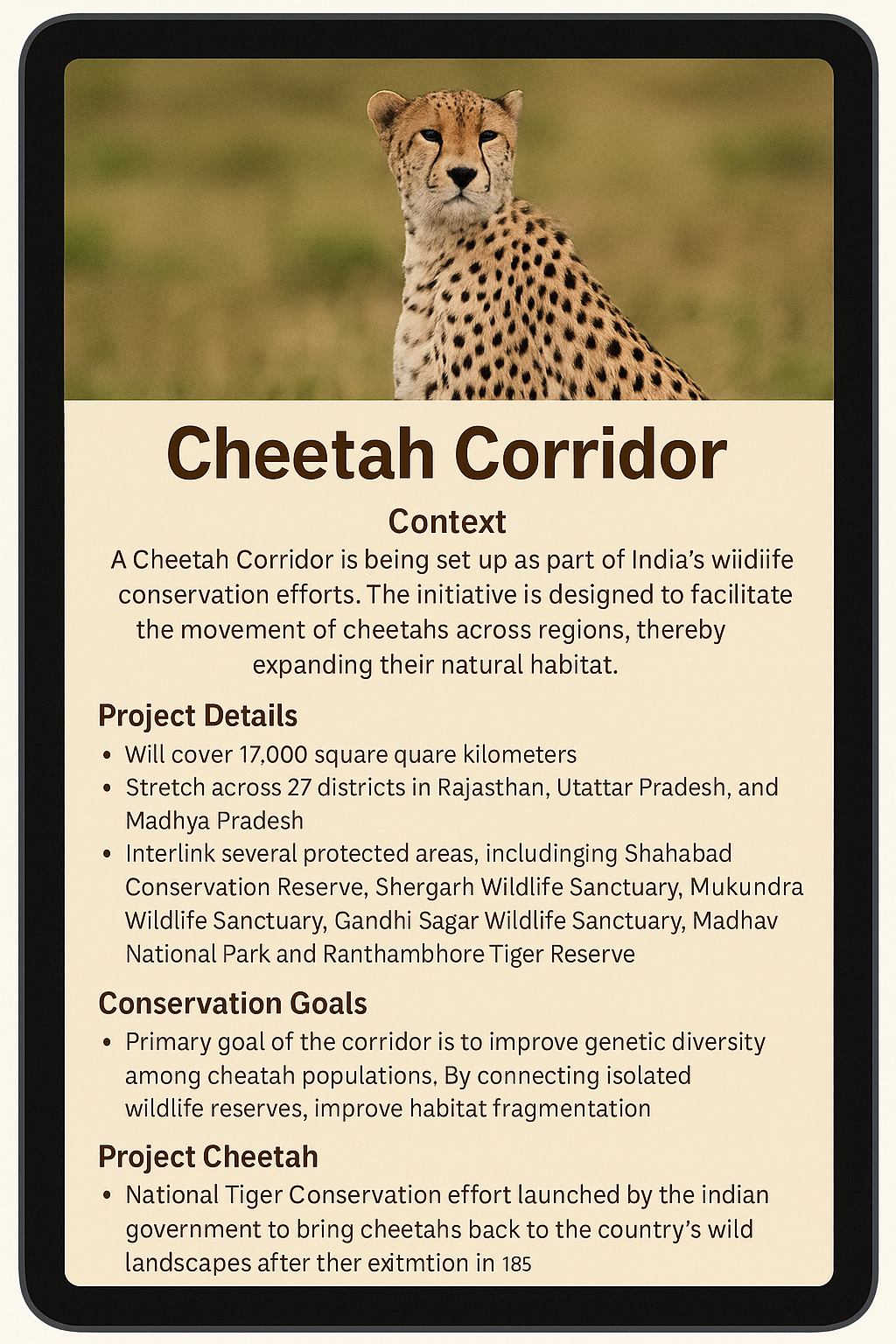
📅 May 2, 2025, Post 4: 🐾 The Return of the Sprinting Ghost: Cheetah Corridor |Mains Essay Attached | Target IAS-26 MCQs Attached: A complete Package!
🐾 The Return of the Sprinting Ghost

NATIONAL HERO — PETAL 025
📅 May 2, 2025
Thematic Focus: Environment, Biodiversity Conservation, Wildlife Corridors, GS III
🌿 Opening Whisper
Where forests whisper and grasses sway, the ghost of speed is finding its way.
🔍 Key Highlights
• India is launching a Cheetah Corridor Project covering 17,000 square kilometres across 27 districts in Rajasthan, Uttar Pradesh, and Madhya Pradesh.
• The corridor will link protected areas such as Shahabad Reserve, Mukundra and Shergarh Sanctuaries, Gandhi Sagar WLS, Madhav National Park, and Ranthambhore Tiger Reserve.
• The objective is to facilitate cheetah movement, expand natural habitat, and increase genetic diversity among populations.
🐆 Conservation Goals & Project Background
🔸 Why a Cheetah Corridor?
• The initiative will connect fragmented wildlife habitats, enabling cheetahs to roam, find mates, and repopulate naturally.
• It aims to counter inbreeding, strengthen biodiversity, and restore ecological balance in central India.
🔸 Project Cheetah
• Launched after cheetahs were declared extinct in India in 1952.
• Involves relocating cheetahs from Africa to Indian sanctuaries.
• Intended to enhance wildlife tourism, restore grassland ecosystems, and revive India’s lost big cat lineage.
🧠 Concept Capsule: Why Corridors Matter
Wildlife corridors are continuous stretches of habitat that connect two or more protected areas, allowing species to migrate, mate, and survive.
Corridors reduce man-animal conflict, increase genetic diversity, and mitigate habitat fragmentation—one of the leading causes of extinction.
🐅 Institutional Support
- Project endorsed by National Tiger Conservation Authority (NTCA) and Wildlife Institute of India (WII).
- Scientific surveys have marked the Kuno-Gandhi Sagar landscape as ideal cheetah territory.
📘 GS Paper Mapping
Prelims:
• Project Cheetah
• NTCA, WII
• Protected Areas in Central India
• Cheetah Corridor: States & Reserves
Mains:
• GS III – Environment: Conservation, Biodiversity
• GS III – Government policies for reintroduction of species
• GS III – Role of corridors in ecosystem connectivity
🔮 A Thought Spark — by IAS Monk
The cheetah is not just a cat returning home — it is memory returning to the wind, and freedom stitched back into the land.
High Quality Mains Essay For Practice :
Word Limit 1000-1200
The Return of the Sprinting Ghost: Cheetahs, Corridors, and Conservation Ethics
“What is man without the beasts? If all the beasts were gone, man would die from a great loneliness of spirit.”
— Chief Seattle
On Indian soil once again, the cheetah runs — not as myth or memory, but as muscle and breath. After vanishing in 1952, this fastest land animal is finding its way back into India’s wild heart through Project Cheetah and a newly announced Cheetah Corridor, spanning 17,000 square kilometres across Rajasthan, Madhya Pradesh, and Uttar Pradesh.
This is not merely a wildlife reintroduction project. It is a reconstruction of an ecological story, a reweaving of interrupted threads, and perhaps, a lesson in coexistence and humility for a species—us—that has too often assumed mastery over nature.
The Corridor: From Fragmentation to Flow
The Cheetah Corridor initiative aims to connect fragmented habitats across 27 districts by interlinking six major protected areas—including the Shahabad Reserve, Mukundra Hills, Shergarh, Madhav National Park, and the iconic Ranthambhore Tiger Reserve. These patches, once isolated, will now act as nodes in a living network, allowing cheetahs to roam, migrate, breed, and thrive.
Such corridors serve multiple purposes. They:
- Enhance genetic diversity, reducing inbreeding.
- Support seasonal migration and natural dispersal.
- Allow other species—deer, antelope, birds—to benefit.
- Reduce the risk of conflict with human settlements by providing clear movement paths.
India’s ecological geography, marked by rapid urbanization and land-use changes, demands precisely such solutions: not just isolated sanctuaries, but integrated landscapes.
Project Cheetah: A Return from Extinction
When cheetahs were officially declared extinct in India in 1952, it was the result of overhunting, habitat loss, and regal apathy. Project Cheetah, launched decades later, aims to reverse that finality. It involves importing cheetahs from Namibia and South Africa, selecting Indian habitats that resemble their native savannas, and re-establishing them in reserves like Kuno-Palpur and Gandhi Sagar.
But the project is not without challenges:
- Cheetahs require vast, open grasslands—a rare commodity in India.
- They are vulnerable to conflict with larger predators, like leopards.
- Their diet, disease resistance, and adaptation to Indian ecology require constant monitoring.
Still, it is a visionary step. It reminds us that conservation is not just about protecting what exists—it is also about reviving what has been lost.
The Ethical Arc of Rewilding
Reintroducing a species isn’t a simple scientific act. It’s also a moral statement. Are we bringing cheetahs back for tourism and pride? Or are we genuinely trying to repair ecological damage?
True rewilding is about:
- Restoring balance, not spectacle.
- Making space for species, not merely showcasing them.
- Recognizing that humans must adapt around ecosystems, not vice versa.
For rewilding to succeed, community engagement is critical. Local populations must see the cheetah not as a threat, but as a symbol of shared heritage. Eco-tourism, education, and compensation mechanisms must walk alongside the animal’s return.
Why Cheetahs Matter
Ecologically, cheetahs are top predators but not apex ones. They help:
- Regulate prey populations, especially gazelles and small antelopes.
- Maintain savanna and grassland health, by preventing overgrazing.
- Act as indicators of ecosystem integrity—their survival reflects how well the land is doing.
But more than that, cheetahs offer us a metaphor. Their sprint is not just about speed—it’s about precision, vulnerability, and elegance. In a world of aggressive extraction, the cheetah reminds us of grace in survival.
Scientific Backing and Institutional Support
The corridor and Project Cheetah are not whimsical. They have been endorsed by the National Tiger Conservation Authority (NTCA) and the Wildlife Institute of India (WII)—two of the country’s top biodiversity research bodies.
The Kuno-Gandhi Sagar landscape, in particular, has been assessed as having:
- Suitable prey base
- Minimal human-wildlife conflict zones
- Contiguous protected patches
- Compatible climate and topography
This alignment of policy, science, and geography strengthens the project’s potential success.
Corridors as Climate Resilience Tools
As the climate crisis intensifies, corridors offer another layer of value:
- They allow species to migrate in response to temperature shifts.
- They ensure ecological continuity even if local patches degrade.
- They can act as carbon sinks, especially when forests are included.
Thus, corridor-based conservation isn’t just for animals — it’s for future-proofing ecosystems in the face of environmental unpredictability.
Conclusion: The Land Remembers
When the cheetah sprints across Indian soil again, it won’t just be a return—it will be a reclamation. Of space. Of memory. Of ecological integrity.
We are not just saving a species. We are relearning humility, recognizing that extinction is not the end, and that hope can be engineered—through science, ethics, and will.
India’s Cheetah Corridor is not just about connecting parks — it’s about reconnecting with the soul of the wild.
“What is man without the beasts? If all the beasts were gone, man would die from a great loneliness of spirit.”
— Chief Seattle
Target IAS-26: Daily MCQs :
📌 Prelims Practice MCQs
Topic: Project Cheetah, Wildlife Corridors, Conservation Policies
MCQ 1 — Type 1: How many statements are correct?
Q. Consider the following statements about India’s Cheetah Corridor and related initiatives:
1. The proposed Cheetah Corridor will connect protected areas across three states and cover more than 20,000 square kilometres.
2. The project aims to enhance genetic diversity and reduce habitat fragmentation.
3. The National Biodiversity Authority (NBA) and Central Zoo Authority (CZA) are the primary endorsing bodies of Project Cheetah.
4. The Kuno-Gandhi Sagar landscape has been identified as ideal for cheetah reintroduction.
How many of the above statements are correct?
A) Only two
B) Only three
C) All four
D) Only one
🌀 Didn’t get it? Click here (▸) for the Correct Answer & Explanation.
✅ Correct Answer: B) Only three
🧠 Explanation:
• Statement 1 is incorrect — The corridor spans 17,000 sq. km, not more than 20,000.
• Statement 2 is correct — key goal is improving genetic diversity and reducing fragmentation.
• Statement 3 is incorrect — NTCA and WII, not NBA or CZA, are the endorsing bodies.
• Statement 4 is correct — Kuno-Gandhi Sagar landscape is a chosen site.
MCQ 2 — Type 4: Direct factual
Q. Which of the following protected areas is not part of the proposed Cheetah Corridor in India?
A) Mukundra Hills Wildlife Sanctuary
B) Ranthambhore Tiger Reserve
C) Sariska Tiger Reserve
D) Shahabad Conservation Reserve
🌀 Didn’t get it? Click here (▸) for the Correct Answer & Explanation
✅ Correct Answer: C) Sariska Tiger Reserve
🧠 Explanation:
• Sariska is not among the reserves listed in the Cheetah Corridor.
• The corridor includes: Shahabad, Ranthambhore, Mukundra, Gandhi Sagar, Madhav National Park, etc


















